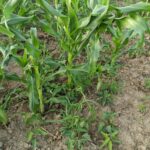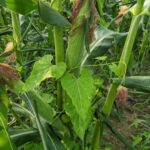Honeyvine Milkweed
What is it?
Honeyvine milkweed (Cynachum laeve) is a perennial, deciduous, vining member of the milkweed family, Asclepiadaceae. It is native to the United States and can serve as a host for monarch butterfly larvae. Honeyvine milkweed tends to be more problematic in production systems with reduced or no tillage, including perennial fruits. It can also be more problematic in field edges near fencerows.
Identification
The growth habit of honeyvine milkweed is trailing, but once it encounters an upright object (other plants, fences) it becomes an upright, twining vine (Figure 1). Plants lack tendrils and instead climb upright objects by a process known as nutation, tightly encircling an object (Figure 2).
- Figure 1
- Figure 2
Stems are thin and may reach to 10 feet or more. When stems are broken, they may exude a white sap.
Leaves are heart-shaped and appear in pairs, one each on opposite sides of the stem. Primary leaf veins are distinctly white.
Small, white, tube-shaped flowers appear in clusters in mid-to-late summer and are followed by tear-drop shaped, green “pods” (follicles). The seed “pods” resemble those of common milkweed, but are smooth in appearance. Like common milkweed, the seed “pod” will split at a single suture, revealing flat brown seeds.
Belowground, honeyvine milkweed taproots reach to at least 6 feet deep, and the plant has an extensive network of lateral roots. Roots contain buds capable of producing new shoots (Figure 3). The ability of root fragments to successfully regenerate varies with fragment size and depth. Generally, larger and shallowly buried root fragments are more likely to generate new shoots and successfully establish and grow compared to small and deeply buried root fragments.
Management
Seed germination under field conditions is generally less than 60%. If seedlings are present, they should be removed before 5 weeks of age. At this point, seedlings are capable of producing root buds that can sprout and regenerating the plant (Coble and Slife 1970).
In annual production systems, tillage can be used to suppress honeyvine milkweed. Repeated cultivation will be necessary to eradicated established plants.
Herbicides can suppress honeyvine milkweed, but often do not provide complete control. Research from the University of Kentucky suggests that pre-emergence applications of flumioxazin, oxyfluorfen, norflurazon, and simazine can provide 4 to 5 weeks of control in fruit production systems (Masabni 2007). Auxinic herbicides, including fluroxypyr and 2,4-D can provide suppression as well. Fomesafen, acifluorfen, lactofen, glufosinate, and basagran can kill the top growth, but will not affect roots. Control with glyphosate is variable and often requires repeated applications. Consult the Midwest Vegetable Production Guide (mwveguide.org) and the Midwest Fruit Pest Management Guide (https://ag.purdue.edu/department/hla/extension/sfg-sprayguide.html) to determine recommended herbicides for your specific crop. Herbicides should target emerging or trailing plants before they start to climb up the crop. This allows for more targeted weed control and lower use rates.
References:
Coble, HD and FW Slife. 1970. Development and control of honeyvine milkweed. Weed Science. 18:352-356. DOI: https://doi.org/10.1017/S0043174500079960
Masabni JG. 2007. Honeyvine milkweed control in tree fruits, small fruits, and grapes (HO-85). University of Kentucky Extension Service.


